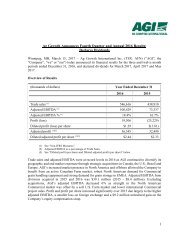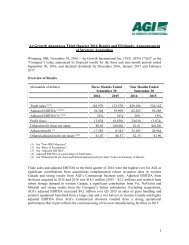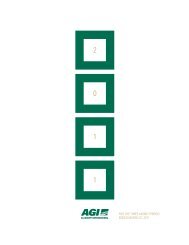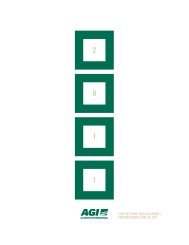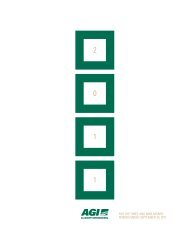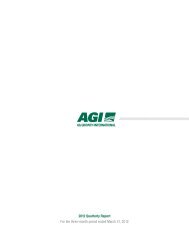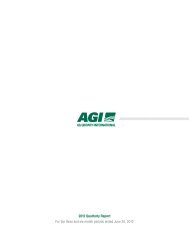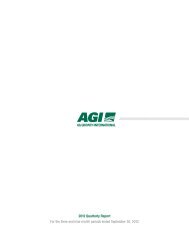2016 Annual Report For Web 7.3MB
Create successful ePaper yourself
Turn your PDF publications into a flip-book with our unique Google optimized e-Paper software.
WESTEEL<br />
2015<br />
Westeel has offered quality<br />
steel storage systems for<br />
over a century. Westeel’s<br />
comprehensive catalogue<br />
of products includes<br />
on-farm and commercial<br />
grain handling and storage<br />
solutions for today’s<br />
agricultural industry, as well<br />
as storage and containment<br />
systems to meet the needs<br />
of the petroleum, water and<br />
industrial sectors.<br />
Derecognition<br />
A financial asset is derecognized when the rights to receive cash flows<br />
from the asset have expired or when AGI has transferred its rights to<br />
receive cash flows from the asset.<br />
Impairment of financial assets<br />
AGI assesses at each reporting date whether there is any objective<br />
evidence that a financial asset or a group of financial assets is impaired.<br />
A financial asset is deemed to be impaired if, and only if, there is<br />
objective evidence of impairment as a result of one or more events that<br />
has occurred after the initial recognition of the asset [an incurred “loss<br />
event”] and that loss event has an impact on the estimated future cash<br />
flows of the financial asset or the group of financial assets that can be<br />
reliably estimated.<br />
Trade receivables and other assets that are not assessed for<br />
impairment individually are assessed for impairment on a collective<br />
basis. Objective evidence of impairment includes the Company’s past<br />
experience of collecting payments as well as observable changes in<br />
national or local economic conditions.<br />
<strong>For</strong> financial assets carried at amortized cost, AGI first assesses<br />
individually whether objective evidence of impairment exists individually<br />
for financial assets that are individually significant, or collectively for<br />
financial assets that are not individually significant. If AGI determines<br />
that no objective evidence of impairment exists for an individually<br />
assessed financial asset, it includes the asset in a group of financial<br />
assets with similar credit risk characteristics and collectively assesses<br />
them for impairment. Assets that are individually assessed for<br />
impairment and for which an impairment loss is, or continues to be,<br />
recognized are not included in a collective assessment of impairment.<br />
If there is objective evidence that an impairment loss has occurred, the<br />
amount of the loss is measured as the difference between the asset’s<br />
carrying amount and the present value of estimated future cash flows.<br />
The present value of the estimated future cash flows is discounted at<br />
the financial asset’s original effective interest rate.<br />
The carrying amount of the asset is reduced through the use of an<br />
allowance account and the amount of the loss is recognized in profit or<br />
loss. Interest income continues to be accrued on the reduced carrying<br />
amount and is accrued using the rate of interest used to discount<br />
the future cash flows for the purpose of measuring the impairment<br />
loss. The interest income is recorded as part of finance income in the<br />
consolidated statements of income.<br />
Loans and receivables, together with the associated allowance, are<br />
written off when there is no realistic prospect of future recovery.<br />
If, in a subsequent year, the amount of the estimated impairment<br />
loss increases or decreases because of an event occurring after the<br />
impairment was recognized, the previously recognized impairment loss<br />
is increased or reduced by adjusting the allowance account. If a writeoff<br />
is later recovered, the recovery is credited to finance costs in the<br />
consolidated statement of income.<br />
<strong>For</strong> available-for-sale financial investments, AGI assesses at each<br />
reporting date whether there is objective evidence that an investment<br />
or a group of investments is impaired. In the case of equity investments<br />
classified as available-for-sale, objective evidence would include a<br />
significant or prolonged decline in the fair value of the investment<br />
below its cost. “Significant” is evaluated against the original cost of the<br />
investment and “prolonged” against the period in which the fair value<br />
has been below its original cost. Where there is evidence of impairment,<br />
the cumulative loss – measured as the difference between the<br />
acquisition cost and the current fair value, less any impairment loss on<br />
that investment previously recognized in the consolidated statements of<br />
income – is removed from other comprehensive income and recognized<br />
in the consolidated statements of income. Impairment losses on equity<br />
investments are not reversed through the consolidated statements of<br />
income; increases in their fair value after impairment are recognized<br />
directly in other comprehensive income. In the case of debt instruments<br />
classified as available-for-sale, impairment is assessed based on the<br />
same criteria as financial assets carried at amortized cost. However,<br />
the amount recorded for impairment is the cumulative loss measured<br />
as the difference between the amortized cost and the current fair value,<br />
less any impairment loss on that investment previously recognized in<br />
the consolidated statements of income. If, in a subsequent year, the fair<br />
05 CONSOLIDATED FINANCIAL STATEMENTS<br />
FIELD TO CONSUMER<br />
<strong>2016</strong> ANNUAL REPORT<br />
CONSOLIDATED FINANCIAL STATEMENTS 84



